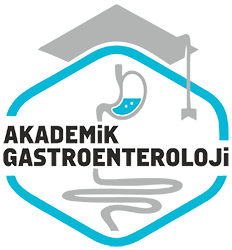Behçet hastalığında üst gastrointestinal sistem bulgulari ve Helikobakter pilori sıklığı
Upper gastrointestinal system findings and Helicobacter pylori frequency in patient’s with Behçet’s disease
- Ana Sayfa
- Sayılar
- Behçet hastalığında üst gastrointestinal sistem bulgulari ve Helikobakter pilori sıklığı...
Özet
Giriş ve amaç: Behçet hastalığı agiz mukozasinda ülserasyonlar, göz lezyonlari, genital ülserasyonlar ve paterji testi pozitifliği ile karakterize, etyolojisi kesin olarak belli olmayan, kronik tekrarlayici bir hastalıktir. hastalık agizdan anüse kadar gastrointestinal kanalin herhangi bir kismi- ni etkileyebilir. Helikobakter pilori (Hp) enfeksiyonu, dünyadaki en yaygi n bakteriyel gastrointestinal hastalık olup, duodenal ve mide ülserinin patogenezinde rol oynamaktadır. Bizim amacımiz bölgemizde yaşayan behçetli hastalardaki endoskopik olarak gastrointestinal patolojilerin sikli gini ve Hp ile ilişkisini araştırmaktir. Gereç ve yöntem: Çalışmamıza Behçet hastalığı tanısı almis 21 hasta (12 erkek, 9 kadın) dahil edildi. Dispeptik yakinmalari sebebiyle tüm hastalara üst gastrointestinal sistem endoksopisi uygulandi. Hp varligini gösterebilmek amacıyla mide antrum, angulus yayi ve korpustan biyopsiler alındı. Bulgular: Hastalarimi- zin yaş ortalaması 36±7.7 yıl (24-52), ortalama hastalık süresi 60.5±75.8 ay (1-324) idi. Endoskopik inceleme sonucu hastalarimizin tümünde gastrit (% 100), 3’ünde (% 14.2) özofajit. 5’inde (% 23.8) mide ülseri, 11’ inde duodenit (% 52.3) tespit ettik. Histopatolojik inceleme sonucu 16 hastada (% 76.1) Hp pozitif kronik gastrit, 5 hastada (% 23.8) Hp negatif kronik gastrit bulundu. Kontrol grubunun 9’unda (% 42.8) tespit edilebilen Hp pozitiflik orani ile aralarinda istatistiksel olarak anlamli ilişki tespit edildi.(p:0.028) hastalığın aktif dönemde olduğu 6 hastanın hepsinde histopatolojik olarak Hp (+) kronik aktif gastrit tespit edildi. Sonuç: Behçet tanısıyla takip edilen ve dispeptik şikayetleri olan hastalara üst gatsrointestinal sistem endoskopisi yapilmalidir. hastalığı aktif dönemde olan dispeptik şikayetlere sahip hastalara, eger endoskopi ihtimali yoksa Hp eradikasyonu uygulanmalidir.
Abstract
Background/aim: Behçet’s disease (BD) is a chronic recurrent systemic disease of unknown etiology characterized by the presence of oral ulceration, eye lesions, and positive pathergy test. Gastrointestinal system involvement may affect all areas from the esophagus to the anus. Helicobacter pylori (Hp) infection is the most common bacterial gastrointestinal infection worldwide and has a role in duodenal and gastric ulcer disease. In this study, we aimed at studying the frequency of gastrointestinal pathologies endoscopically and that of Hp in patients with Behçet’s disease living in our region. Materials and methods: Twenty one patients (12 male, 9 female) who met the diagnostic criteria of the international study group for Behçet’s disease were included in our study. Upper gastrointestinal endoscopy was performed in all patients because of dyspeptic complaints. Biopsies were taken to indicate the occurrence of Hp from gastric antrum, corpus and angulus. Results: The mean age of patients was 36±7.7 years (24-52). Their mean disease intervals were 60.5±75.8 months (1-324). Endoscopic examinations showed esophagitis in 3 patients (14.2%), gastric ulcer in 5 patients (23.8%), duodenitis in 11 patients (52.3%), and gastritis in all patients (100%). Histopathological investigations revealed Hp-positive chronic active gastritis in 16 patients (76.1%), and Hp-negative chronic gastritis in 5 patients (23.8%). There was a statistically significant relation when patients were compared with Hp positivity rate detected in 9 of control group. Histopathologically Hp (+) chronic gastritis was detected in all 6 patients with active disease. Conclusion: Upper gastrointestinal endoscopy should be done in Behçet’s disease patients with dyspeptic complaints. Hp eradication should be applied to patients with dyspeptic complaints and with active disease if there is no opportunity for endoscopy.



